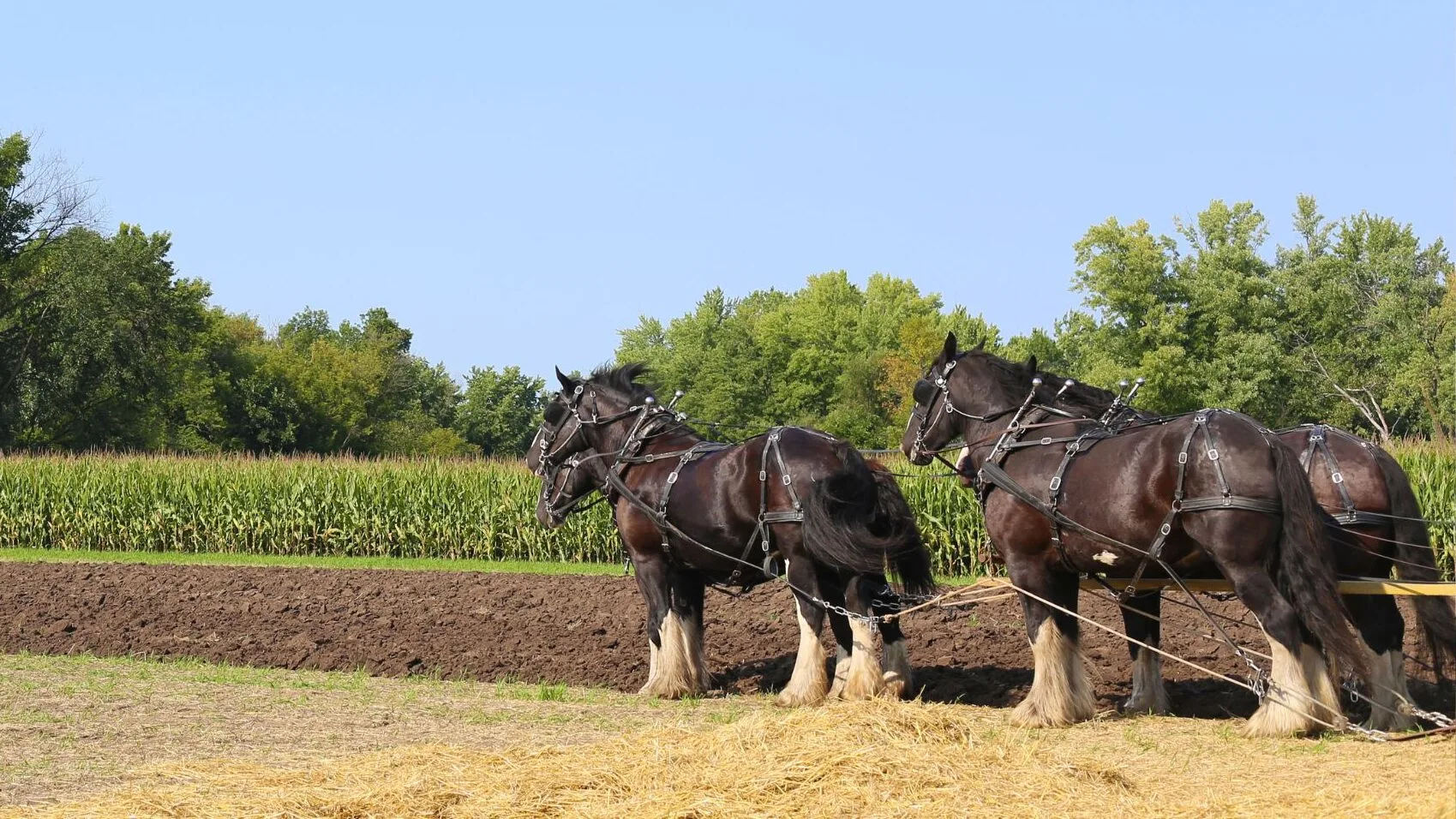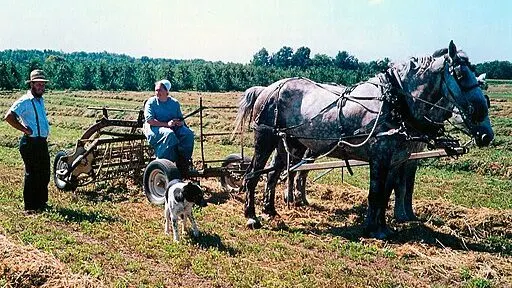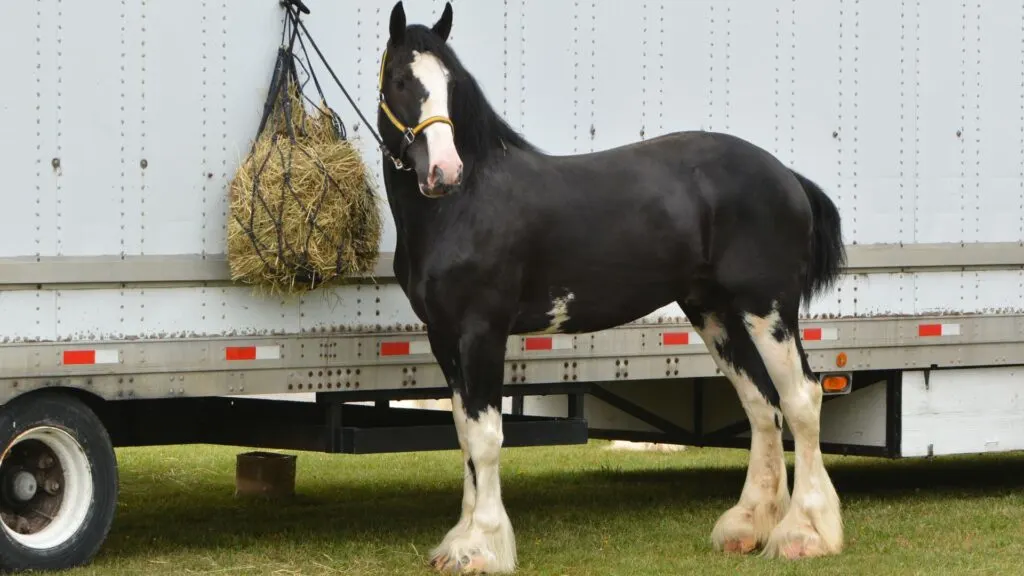Last updated: October 17, 2023
Draft horses, recognized for their powerful build, have long been indispensable to farmers, aiding in plowing fields, sowing seeds, and transporting crops. Their utility was not limited to rural areas; in cities, too, they were pivotal in moving goods and people before the advent of widespread automobile use.
This isn’t only a nod to historical practices. Today, draft horses are still important as we try to find ways to live without harming our planet. Employing them in farming, for instance, prevents the need for fuel-guzzling tractors and machinery, subsequently reducing pollution and easing our environmental impact.
In this article, we will traverse the fascinating world of draft horses, exploring their potential role in modern sustainable farming and weighing how a return to these traditional methods might signify a stride forward in ecological conservation. Together, let’s explore their storied past, current relevance, and prospective role in our future sustainability efforts.

The Historical Significance of Draft Horses
In the days before large machines and technology took over our fields and streets, large draft horses were the stars of the show. With their powerful muscles and calm demeanor, they worked side-by-side with farmers to cultivate the land, helping sow seeds and transport hefty loads of crops.
In cities and towns, they pulled wagons filled with goods, people, and sometimes even helped move houses. Then came a significant change known as the Industrial Revolution, a time when machines started taking over many jobs that were once done by hand and horses.
Trains, tractors, and automobiles became the new way to move goods and people, providing faster and, at that time, more efficient means of transportation and farming. Horses slowly trotted away from the limelight, making way for engines and machinery to lead the way in progress and development.
Interestingly, in recent years, some farmers and communities have started turning back the clock and reintroducing draft horses to their fields and farms. Why, you might ask? Well, these gentle giants have a natural way of being kind to our Earth.
Unlike tractors, they don’t need gasoline and don’t pollute the air. Plus, their hooves are much gentler on the soil than heavy machinery, preventing damage and helping keep it healthy for crops to grow. This ‘step back in time’ is, in many ways, a step forward in taking better care of our planet and showcases the timeless value of draft horses in sustainable practices.
Comparing Horse-Power to Machine-Power
When we think about energy, it’s all about what’s needed to get work done. For machines like tractors, we need fuels like diesel or petrol, which we have to keep buying. But horses? They get their energy from food. Grains, hay, and grasses are what keep them going. Horses don’t just eat food – they help create it, too, by fertilizing the soil naturally as they work.

Carbon Footprint: Analyzing the Environmental Impact
Talking about carbon footprint means discussing how much carbon dioxide (CO2) gets released into the air by different activities. Machines, when they burn fuel, release quite a bit of CO2, which is not so good for our air and atmosphere. On the flip side, horses release very little, and the plants they eat even absorb CO2, making them a friendlier option for our planet.
Dependence on Non-Renewable Resources: Fossil Fuels vs. Biological Energy
Machines need fossil fuels (like petrol and diesel), which are not only limited but also take millions of years to form, making them non-renewable. Once we use them up, they’re gone.
Horses, however, depend on biological energy – their food can be grown year after year, making sure we won’t run out of ‘horse fuel’ as long as we manage our resources wisely.
Impact on Biodiversity and Soil Health
Biodiversity means having many different types of plants and animals in an area. Healthy soil means everything growing in it can thrive. Horses support both. As they move around and graze, they help seeds spread, encouraging various plants to grow.
Their hooves are gentle to the ground, preserving the homes of tiny creatures in the soil. Machines, with their weight and how they work the land, can sometimes harm these ecosystems, reducing biodiversity and negatively affecting soil health.
Table: Comparing Horse-Power and Machine-Power in Agriculture
| Aspect | Horse-Power | Machine-Power |
|---|---|---|
| Energy Source | – Biological energy (feed) | – Non-renewable resources (fuel, electricity) |
| Carbon Footprint | – Low: Produces manure, which can be recycled as fertilizer | – High: Emits greenhouse gases and potentially involves harmful manufacturing processes |
| Biodiversity Impact | – Varying: Costs associated with the purchase, stabling, and care of horses | – Negative: Can disrupt local ecosystems due to pollution and physical disturbance |
| Soil Health | – Gentle: Hooves are less compacting than machinery, preserving soil structure | – Potentially Harmful: Heavy machinery can cause soil compaction, affecting plant growth and water infiltration |
| Labor Intensity | – High: Requires human handling for navigation and management | – Low: Can cover large areas without constant human intervention |
| Initial Costs | – Varying: Costs associated with purchase, stabling, and care of horses | – High: Purchase of machinery and ongoing maintenance costs |
| Skills Required | – Specialized: Requires knowledge in horse care and management | – Technical: Requires understanding of machinery operation and maintenance |
| Community Aspect | – High: Encourages community involvement and can be integrated into social activities | – Low: Often involves independent operation with minimal social interaction |

The Role of Draft Horses in Sustainable Agriculture
Draft horses stand out as remarkable, eco-friendly powerhouses, tilling our fields without contributing to fossil fuel emissions. Let’s explore how these animals not only nurture the soil beneath their hooves but also sow the seeds for a greener future in farming.
Benefits of Horse Farming
1. Soil Preservation and Health
Did you know that the way horses walk and work is super gentle on the land? Unlike heavy machines that can squish and hurt the soil, horses’ hooves are much kinder, keeping it fluffy and healthy. Healthy soil is a secret recipe for growing strong and yummy crops!
2. Reduced Fuel Dependence and Emissions
Horses don’t need petrol or diesel to work – they just need good food and water. This means using horses doesn’t create the smoke and pollution that machines do. So, farming with horses is like giving our air a little break from all that smoke machines make.
3. Enhancement of Local Biodiversity
When horses work on a farm, they help more types of plants and animals to live there. They carry seeds on their bodies, spreading them around, and help create new homes for insects and birds, making the farm a busy, lively place!
Challenges of Implementing Horse-Powered Farming
1. Initial Costs and Training
Starting to farm with horses isn’t as easy as it might seem. Horses and the tools needed to farm with them can be expensive to buy. Plus, both farmers and horses need special training to work together safely and effectively, which can also cost time and money.
2. Time and Labor Intensity
Working with horses can be hard and slow compared to using fast, powerful machines. Planting and harvesting with horses takes more time and people, which might be tricky for really big farms or during busy farming seasons.
3. Accessibility and Scalability Issues
While small farms might find success with horse-powered practices, larger farms may find it difficult to manage big fields and crops with horse teams. Also, not every place has easy access to draft horses or people who know how to work with them, which can make it hard for this kind of farming to grow.

Sustainability Lessons from the Amish
The Amish community, with its iconic horse-drawn buggies and plows, has long exemplified a way of life that eschews modern machinery in favor of simpler, more sustainable practices. By choosing horses over tractors and hand tools over electric ones, they demonstrate a way of living that inherently leaves a smaller ecological footprint.
Their practices afford us lessons in minimizing waste and reducing energy consumption, not just in farming but in various aspects of daily living, intertwining simplicity with sustainability. However, embracing the Amish way does come with its own set of trade-offs.
Economically, shunning certain technologies might limit productivity and financial gains. The avoidance of modern machinery, while ecologically commendable, can also mean harder, more manual labor and potential constraints on scalability and efficiency.
Here’s a YouTube video about Amish farming practices.
These aspects warrant contemplation about the economic and physical costs versus the ecological and social benefits. While there are rich lessons to be learned from the Amish, transplanting their practices into non-Amish contexts isn’t without challenges.
The deeply intertwined relationship between their practices and religious beliefs, the existing social structure, and a unified commitment to a particular way of living are aspects that might not be readily replicated elsewhere.
Thus, while we can draw inspiration and adopt certain practices, a discerning approach is needed to determine how such sustainability lessons can be authentically and effectively integrated into other societal and cultural contexts.

Psychological and Social Benefits
Large draft horses aren’t just great workers; they’re wonderful companions, too. People who spend time with these gentle giants often feel calmer and happier. Their steady, peaceful presence can make the stresses of the day melt away.
Farmers working alongside horses might find their days to be not just productive but also mentally soothing. Even just watching them graze or move can be a peaceful and mindful experience, bringing a unique form of therapy to those who engage with them on the farm.
Community Building and Social Connections Through Shared Values
When a group of people all care deeply about the same thing, like sustainable farming with horses, a special kind of community is born. This shared value of preserving the earth and appreciating the noble draft horse can bring folks together in meaningful ways.
Farming cooperatives, community-supported agriculture (CSA), and local farmers’ markets become places where friendships bloom, stories are exchanged, and a collective commitment toward a sustainable future is strengthened. It’s about growing veggies and connections all in one fertile ground!
Enhancing Agricultural Education and Engagement
Having horses on a farm adds a magical element that can turn an ordinary visit into an unforgettable adventure, especially for children. Educational programs on farms that employ horses create opportunities to learn not just about growing food but also about animal care, history, and sustainable living.
Visiting schools or families might engage more deeply when they can interact with the horses, leading to enriched educational experiences. These moments of learning and interaction with the horses sow seeds of respect and understanding towards nature and agriculture in the minds of young and old alike.

Navigating the Challenges
Changing how things have been done for decades isn’t easy. Some folks might raise their eyebrows at going “backwards” to using draft horses instead of modern machines. But it’s essential to communicate that this isn’t about rejecting progress; it’s about choosing a path that honors both the planet and its inhabitants.
Sharing successful stories, providing live demonstrations of horse-powered farming, and opening dialogues about the genuine benefits (and challenges) of such practices can help ease doubts and inspire curiosity among skeptics.
Growing bigger while staying true to sustainable, horse-powered practices can be a tricky path to trot. Larger fields and bigger crops demand more work, and horses have their limits. A balanced approach might involve a mix of traditional horse-powered methods with judicious use of modern technology where absolutely necessary.
Developing and investing in horse-drawn machinery that can handle large-scale operations, as well as exploring cooperative models to share resources and knowledge among farmers, can pave the way toward scalability without compromising core values.
Obstacles like high initial costs, availability of skilled labor, and efficient management of horse-powered farming need thoughtful consideration. Crafting community-supported initiatives, like crowdfunding or “adopt-a-horse” programs, can help alleviate financial burdens.
Establishing training programs and workshops ensures that the art and skill of horse-powered farming are passed down and spread widely. Collaborative farming networks can be formed to share resources, knowledge, and support, turning potential roadblocks into stepping stones towards a sustainable, horse-powered future.

Conclusion: Draft Horses: A Sustainable Farming Solution.
Embracing draft horses in our agricultural practices isn’t merely a nostalgic nod to the past; it’s a conscientious choice for a sustainable future. From enhancing soil health and local biodiversity to fostering psychological wellness and vibrant communities, the merits of horse-powered farming are robust and multifaceted.
However, it does bring its own set of challenges, like addressing skepticism, ensuring scalability, and navigating various roadblocks, all of which require thoughtful, innovative solutions.
Looking forward, draft horses hold a promising position in the realm of sustainable agriculture. Their capability to work in harmony with the environment without the hefty carbon footprint and ecological degradation often associated with mechanized farming presents a viable, albeit challenging, alternative.
Adopting and adapting horse-powered farming methods could pave the way for more ecologically sound, socially enriching, and mentally therapeutic agricultural practices, intertwining sustainability with wholesome living.
And so, we stand at a crossroads, with the potential to blend ancient wisdom with modern sensibilities for a sustainable future in farming. Your support, be it through choosing produce from horse-powered farms, participating in community farming programs, or simply spreading the word about this wholesome practice, can make a difference.
Let’s champion the way toward an agriculture that respects the earth, nourishes our bodies, and enriches our communities. Together, let’s harness the power of draft horses to sow seeds for a future that honors and sustains the delicate balance of our beautiful planet.
